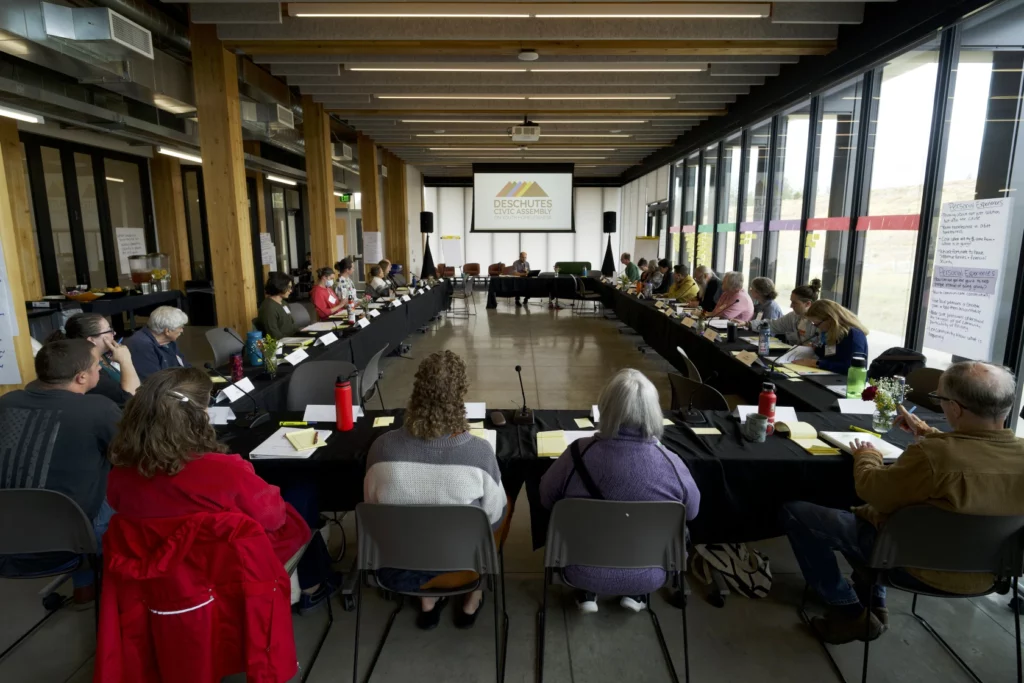An effort in Bend, Ore., backed by big funders looks for answers to youth homelessness.
George Anders, October 3, 2024 — BEND, ORE.
Eliza Wilson is a little nervous as she draws the microphone close to her, but she is determined to share her life story — and its larger lessons — with a vital new audience. “My father was a disabled veteran,” she says. “I first experienced homelessness when I was 5 years old.”
Wilson, who’s 36, leads programs focused on unhoused youth. On this recent Saturday, she is addressing a “citizen assembly,” a grassroots gathering aimed at identifying and promoting solutions to a community’s toughest challenges.
Her audience consists of 30 ordinary Oregonians. They are acupuncturists and elk hunters; house cleaners and retired riverboats pilots. None are public-policy experts. All the same, these participants have been asked to recommend new strategies for combating youth homelessness — a major problem in this affluent central Oregon city and the surrounding rural areas of Deschutes County.
This unusual experiment in small-D democracy is underwritten by more than $250,000 in grants, with the Rockefeller Foundation and Omidyar Network together contributing slightly more than a third. As a key early presenter, Wilson wins rapt attention, clicking through data-rich slides and sharing her story of crisis and recovery. When she finishes, assembly members’ hands shoot up. They want to learn more.
That’s how citizen assemblies should work, says Kevin O’Neil, an innovation specialist at the Rockefeller Foundation. His research shows that a lot of Americans are frustrated with what they perceive as aloofness and gridlock within civic institutions. “People want to be directly involved in decision-making,” O’Neil says. “They recognize the value of expertise, but they don’t want to delegate decision-making to experts.”
Putting power in the hands of citizen assemblies is a popular idea in Europe. It hasn’t found nearly as much traction in the United States, but advocates hope it can be a salve for the country’s toxic division.
Assemblies can “create the conditions to overcome polarization and strengthen societal cohesion,” says Claudia Chwalisz, founder and chief executive of DemocracyNext. Her nonprofit, launched in Paris in 2022, champions assemblies worldwide. Chwalisz hails these gatherings as ways to “create the democratic spaces for everyday people to grapple with the complexity of policy issues, listen to one another, and find common ground.”
At least, that’s the theory.
To succeed, citizen assemblies can’t settle for a few days of harmonious dialogue among well-intentioned strangers. They need to gain attention from decision makers in government and other civic institutions and pave the way for concrete policy changes or new programs. In France, Belgium, and Ireland, such wins have been plentiful. In the United States, results are spottier.
The most fruitful U.S. effort to date was a 2021 people’s assembly in Washington State that produced 148 ideas — including more solar canopies and food composting — to reduce the impacts of climate change. When the state legislature enacted a cap-and-trade system for utilities’ carbon emissions, it drew upon some of the assembly’s ideas.
More often, progress is challenging. An assembly in 2022 in Petaluma, Calif., spun up ideas to repurpose a long-time county fairground site. Two years later, the fair still operates under short-term leases while the site’s long-term destiny remains in limbo. In Colorado’s Montrose County, an assembly in 2023 began collecting bold ideas for improving rural day care, but since then, “it’s been more of a marathon than a sprint,” says its organizer Morgan Lasher.
Can central Oregon do better? It may take years to know the full impact of the youth-homelessness project, but the rollout so far shows the opportunities and challenges of putting citizen assemblies into action.
An Affluent City’s Encampments
High homeless rates in Bend have drawn national attention for more than a decade. The local economy is strong, with a jobless rate of just 4.2 percent and median household income of more than $80,000. But as housing costs have skyrocketed, the spectacle of people living in tent and trailer encampments has become more common in Bend and on rural public land. A January count found more than 1,800 people were homeless in Deschutes County, up from 913 in 2020.
In 2023, DemocracyNext and Healthy Democracy, a Portland, Ore., nonprofit, connected with Bend officials interested in bringing the assembly idea to central Oregon. Josh Burgess, an Air Force veteran who supported community organizations in Afghanistan, moved to Bend and became the proverbial “advance man” for DemocracyNext.

Participants gather around a large table for discussion during the Deschutes Civic Assembly on Youth Homelessness at the Oregon State University Cascades campus.
Operating in a county evenly divided between Democrats and Republicans, Burgess struck up a rapport with both liberal and conservative members on the Deschutes County Board of Commissioners. “It took four or five meetings to get there,” Burgess recalls. Organizers also decided to focus narrowly on homelessness among ages 14 to 24, where opportunities for progress seemed greatest.
To pick the citizens for the assembly, organizers contacted 12,000 of the county’s roughly 200,000 residents. This outreach — and the selection of just 30 participants — was balanced by age, race, gender and geography. Chwalisz sees this as a way to “bring out the collective intelligence of society,” generating insights that a homogeneous group couldn’t find.
The screening, which assemblies call sortition, was costly and time-consuming. Even so, advocates such as Michelle Barsa, head of the building-communities program at Omidyar Network, see it as crucial. Assembly recommendations have far more credibility if they “use an actual representative sample of the community,” she says, “not the people who always show up at town-hall meetings and yell into a microphone for three minutes.”
Gathering at a U-Shaped Table
At the northern edge of Oregon State’s Bend campus, a few hundred yards from the Deschutes River, is the McGrath Family atrium, a sunlight-drenched space with panoramic woodland views. It feels almost like a spa.
As the Bend assembly participants gather for their first session of what’s termed a civic assembly, they take seats around a giant, U-shaped table. Black tablecloths add gravity to the moment. Name tags identify attendees as “Noelle,” “Dave,” “Alex.” The first few hours go slowly, with a lot of history and mechanics of the assembly. But everything perks up, fast, after lunch.
Eliza Wilson takes command, introducing herself as director of runaway and homeless youth services at J Bar J, a social-services organization. She wears black leggings and a lightweight jacket. Her voice is unfailingly steady, but emotions race fast across her face: hope, frustration, empathy, resolve, and more.
“Teens get really good at hiding their homelessness,” Wilson explains. “We don’t share family business outside of the family. I was really fortunate that a high-school counselor pointed me, at age 15, to the first youth shelter that had just opened in Bend. I stayed there for three years, until I graduated from high school. I finally got on my feet at age 21.”
Moments after Wilson finishes, questions start streaming in. “Are there any programs advocating for children to get back to their parents?” one woman wants to know. “Is there open communication between you guys and the school district?” a man asks.
Wilson and other presenters respond with a roadmap of what exists today. They point out how most homeless youth are in a precarious but not hopeless situation, counting on friends or acquaintances for a couch or floor to sleep on. Less than 20 percent are likely to live outside in encampments. Practically everyone in the audience takes notes, focusing closely on the presenters’ messages.
A Different Point of View
The next day, assembly members split into small-group conversations with young adults who were once homeless. Chronic problems — and glimmers of ideas about how to address them — tumble forth in rapid succession. Flaws in the foster parent system. The risk of sexual abuse. The unique challenges that LGBTQ youth face.
Attendees — who shared their thoughts with the Chronicle on the condition that they be identified only by their first name — regarded those conversations as eye-opening and an essential building block in their hunt for policy recommendations.
“I’m coming away with a whole different point of view,” Ken told me. He had arrived believing that poor parenting and drug abuse were the main drivers of teen homelessness, and that affected families should personally address such challenges. Now, he said, he was interested in broader solutions.
Several local officials stopped by to take in some of the assembly proceedings. Phil Chang, a Deschutes County commissioner, praised the process for its ability to “convene diverse stakeholders and develop mutual trust. We didn’t just seek some opinions off the street,” he added. “This produces social license for us to do things that the community wants.”
Conservative county commissioner Tony DeBone is cautiously optimistic, too. Local government hasn’t come up with a good solution to homelessness yet, he notes. DeBone worries that Oregon’s rollback of drug-offense laws has worsened social problems; he also believes that a strengthened local economy would do the most good. Still, he says, he’s willing to see what the assembly can offer.
The next wave of assembly sessions, which will conclude October 6, will concentrate on developing recommendations for local authorities. Members will be in charge, without editing or interference from assembly sponsors, says Linn Davis, program director for Healthy Democracy.
Watching with interest is Tammy Baney, executive director of the Central Oregon Intergovernmental Council. The new proposals’ fates may vary widely, depending on how much bureaucratic resistance or inertia they face, she says.
For example, proposed changes in law enforcement’s interactions with homeless youth could be acted on within a month or two, if local police and sheriff’s department officials are receptive, she says. Other areas could be tougher, such as improving Oregon’s foster-care system, where statewide change has been gridlocked for years.
“It all depends on how much political will there is,” Baney says.


